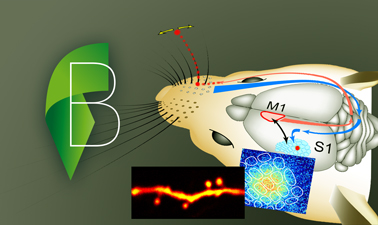
Cellular mechanisms of brain function
The course Cellular Mechanisms of Brain Function aims for a mechanistic description of mammalian brain function at the level of individual nerve cells and their synaptic interactions.
The function of the brain is to govern behavior, and the aim of this course is to causally link biophysical mechanisms with simple behaviors studied in mice. The brain processes information through the concerted activity of many neurons, which communicate with each other through synapses organised in highly dynamic networks. The first goal of the course is to gain a detailed understanding of the structure and function of the fundamental building blocks of the mammalian brain, its synapses and neurons (Weeks 1-3). The second goal is to understand neuronal networks, with specific emphasis on the interactions of excitatory glutamatergic and inhibitory GABAergic neurons (Weeks 4 and 5). The third goal is to place neuronal network function in the context of sensory processing ultimately leading to behavioral decisions and motor output (Weeks 6 and 7).
Each week of the course consists of five videos. Each video is typically ~20 minutes in duration (ranging ~15-30 minutes). You should watch these videos and then complete the associated quiz questions. There are 5-7 quiz questions for each video (except '1.1 Introduction' and '7.5 Concluding remarks'). These quiz questions are labeled as 'Homework'. The quiz questions are multiple choice questions and correct answers count towards passing the course (60% of the total score). The quiz questions associated with each video should take no more than ~5 minutes to do on average. In addition to the quiz questions accompanying each video, there will also be a final exam, which will also be multiple choice questions. The final exam will take ~45 minutes to complete. The final exam will contribute 40% of the total points awarded. To pass the course you must get 50% (or more) in the total points.
The Course Notes summarize the most important aspects of the course and are useful addition to the course content. They were created as part of the BOOC (Book and Open Online Course) collection of the Presses Polytechnique et Universitaires Romandes (PPUR).
Course Outline
Week 1
- 1.1 Introduction
- 1.2 The cell membrane
- 1.3 Ion channels
- 1.4 Membrane potential
- 1.5 Cable properties
Week 2
- 2.1 Voltage-gated channels
- 2.2 Voltage-gating kinetics
- 2.3 The action potential
- 2.4 Action potential propagation
- 2.5 Whole-cell recordings
Week 3
- 3.1 Synaptic transmission
- 3.2 Neurotransmitter release
- 3.3 Presynaptic dynamics
- 3.4 Presynaptic modulation
- 3.5 Electron microscopy
Week 4
- 4.1 Glutamate receptors
- 4.2 Postsynaptic potentials
- 4.3 Glutamatergic circuits
- 4.4 Synaptic plasticity
- 4.5 Dendritic spines
Week 5
- 5.1 GABAergic inhibition
- 5.2 Inhibitory synaptic conductances
- 5.3 Benzodiazepines
- 5.4 GABAergic projections
- 5.5 Neocortical inhibition
Week 6
- 6.1 Brain function and behavior
- 6.2 Man and mouse
- 6.3 Imaging the brain in action
- 6.4 In vivo electrophysiology
- 6.5 Controlling brain function
Week 7
- 7.1 Sensorimotor interactions
- 7.2 Sensory perception
- 7.3 Learning
- 7.4 Brain dysfunction
- 7.5 Concluding remarks
Final Exam
Course Staff
Carl Petersen
Carl Petersen studied physics as a bachelor student in Oxford. During his PhD studies under the supervision of Prof. Sir Michael Berridge in Cambridge he investigated cellular and molecular mechanisms of calcium signalling. In his first postdoctoral period he joined the laboratory of Prof. Roger Nicoll at the University of California San Francisco to investigate synaptic transmission and plasticity in the hippocampus. During a second postdoctoral period, in the laboratory of Prof. Bert Sakmann at the Max Planck Institute for Medical Research in Heidelberg, he began working on the primary somatosensory barrel cortex, investigating cortical circuits and sensory processing. Carl Petersen joined the EPFL in 2003, setting up the Laboratory of Sensory Processing to investigate the functional operation of neural circuits in awake mice during quantified behavior.



